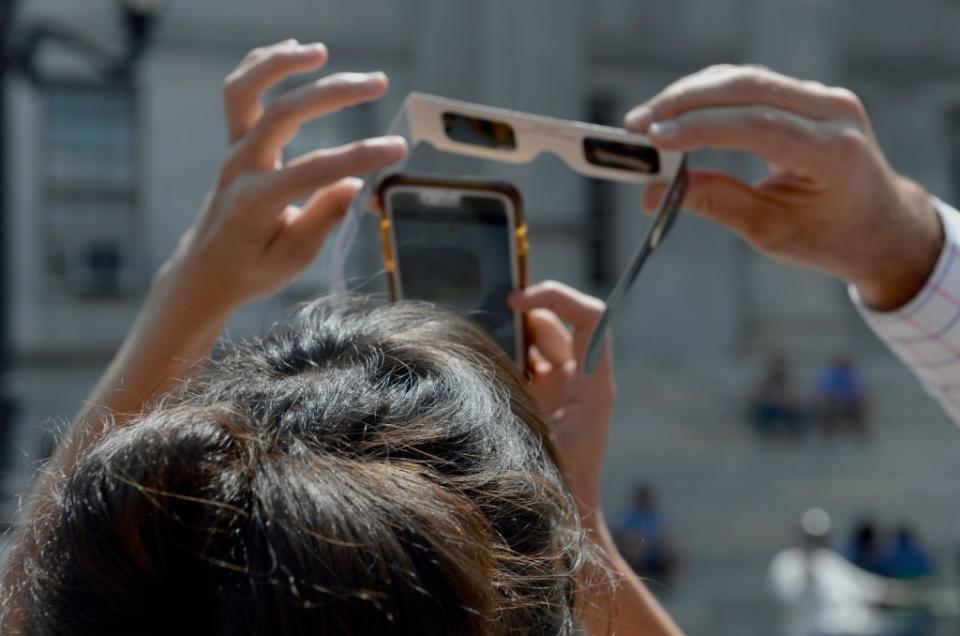How to take a picture of the solar eclipse with your phone

It’ll be gone in a flash — complete darkness for Monday’s solar eclipse will last up to 4 minutes and 28 seconds depending on where you are in the path of totality when the moon blocks the face of the sun.
A picture lasts much longer — and some photographers have long been prepping for the big moment.
Astrophotographer Stan Honda told CNN last week that he’s aiming for Fredericksburg, Texas, with the hopes of clear skies. Though he’s planning to carry four cameras, you don’t need that many to capture the ultra-rare event.
“With pretty much any kind of camera or any lens, you can get a good picture of the eclipse,” Honda explained. “I would just recommend a fairly sturdy tripod, to make your setup pretty steady, and a remote shutter release, because that allows you to take the pictures without jarring or moving the camera too much.”
Here are some other tips to help get that once-in-a-lifetime shot.

Get a solar filter

To fully experience the total eclipse, you’ll need to be located along the more than 100-mile-wide path of totality, from Texas to Maine.
You’ll also need a pair of solar glasses to shield your eyes and a solar filter to protect your smartphone’s camera from sunlight damaging the lens and overexposing your shot.
Ready-made smartphone solar filters include the VisiSolar Smartphone Photo Filter and the Solar Snap Eclipse App Kit, Live Science reports.
You can also make your own solar filter by holding or taping the lens from a spare pair of solar glasses over the lens of your smartphone camera, according to Dr. Ralph Chou, a professor emeritus of optometry and vision science at the University of Waterloo.
Set the focus and exposure

Once you’ve secured your solar filter, you’ll want to make sure you manually set the focus and exposure.
“The automatic settings just won’t work with the filter on, because most of the frame will be black, so it’ll be like taking a picture at night,” Honda told CNN. “Manually focusing would be a big help, too — you can autofocus on the sun, but then you have to disable the autofocus so that your camera doesn’t try to keep focusing through the filter. It’s so dark that it’ll be fooled by the darkness, and it won’t be able to focus.”
To manually set the focus on your phone, tap the moon on your screen.
On an iPhone, a small sun icon should appear to the right of the focus box. Drag the icon up or down to adjust the exposure.
Android users will need to hold their finger on the moon on their screen for several seconds before moving their finger left or right to adjust the focus.
Photographers will also want to turn the flash off for a clear photo.
Be careful with the zoom

As you zoom in, you often lose the quality of the photo depending on the device, so be careful with how close you get.
The iPhone 15 Pro boasts a telephoto camera with 3x optical zoom — which the Washington Post reports will yield the best quality — and up to 15x digital zoom.
Samsung Galaxy S Ultra phones have 3x to 10x optical zoom. The Space Zoom feature allows zooms up to 100x.
But if you don’t have these fancy phones, you can purchase a $20-$50 telephoto lens attachment for 12x to 18x the view.
Use burst mode to capture the ‘diamond ring’

You should also practice with the iPhone’s burst mode feature — which takes multiple photos at once — before the big show.
The solar eclipse is expected to last about two-and-a-half hours, but the most stunning part of the event is known as the “diamond ring,” which occurs right before the eclipse reaches totality and just after.
“It’s this very bright section of the sun, just on one corner of it — it looks like a ring with a diamond on it, and that lasts for just a few seconds, maybe 10 or so,” Honda said.
Use the burst mode for your best shot at capturing the diamond ring.
